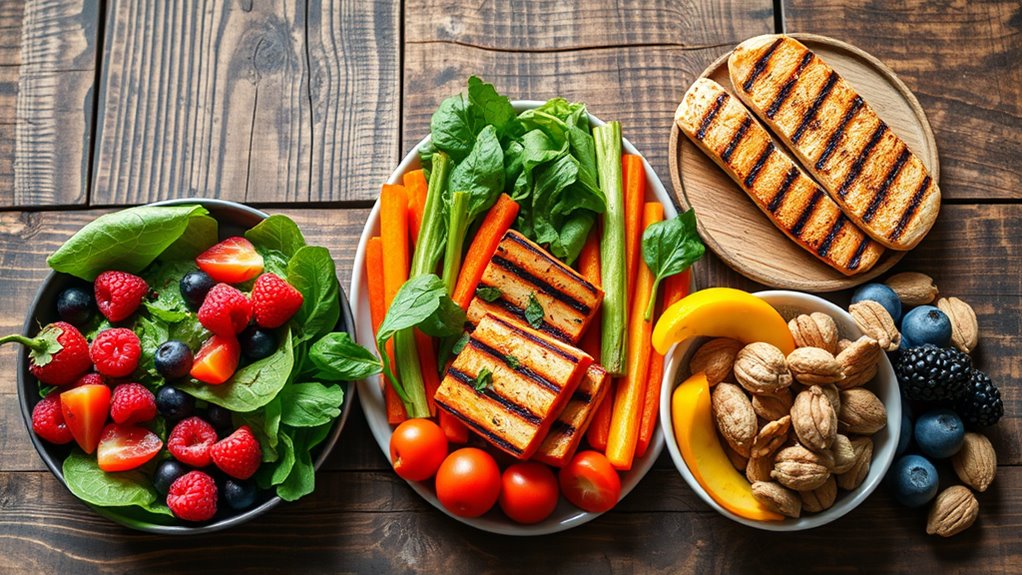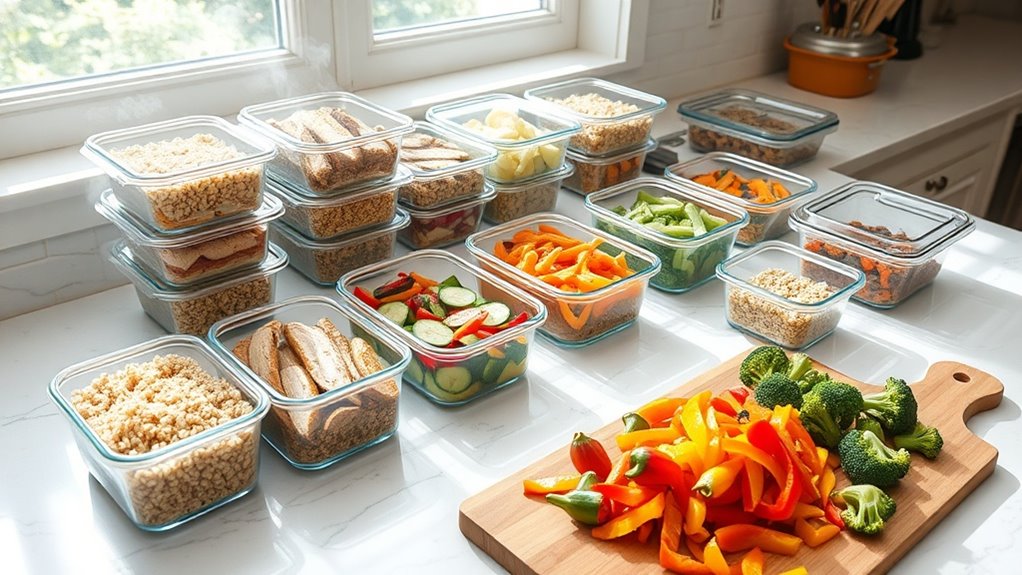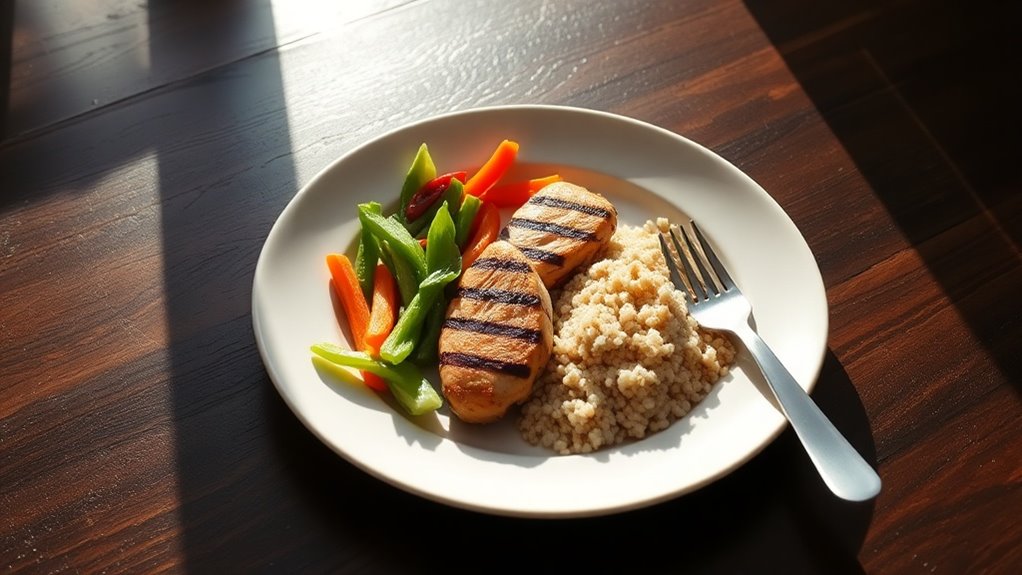The Perfect 3-Day Meal Plan to Jumpstart Fat Loss
Like a key unlocking a gateway to better health, this 3-day meal plan symbolizes your first step toward effective fat loss. You’ll balance nutrient-dense foods with lean proteins and veggies to stabilize energy and curb hunger, drawing from proven nutrition strategies. See how these practical tweaks can ignite lasting changes in your routine.
Day 1 Meal Plan
Day 1 of your 3-day meal plan starts with straightforward, nutrient-focused meals to create a calorie deficit while maintaining energy.
You’ll begin with a breakfast of oatmeal topped with berries and almonds, providing fiber and protein to stabilize blood sugar—backed by studies showing this curbs cravings.
For lunch, enjoy a grilled chicken salad with mixed greens, tomatoes, and olive oil dressing; it’s practical and balances carbs, fats, and proteins for sustained energy.
Dinner features baked salmon with steamed broccoli and quinoa, ensuring you hit essential nutrients without excess calories.
Incorporating drinking water before meals can further enhance your fullness and support your fat loss journey.
Track portions to stay on track with your 3-day meal plan, promoting fat loss effectively.
Day 2 Meal Plan
Moving to Day 2 of your 3-day meal plan, you’ll find breakfast options that include nutrient-dense choices like eggs and veggies to kickstart your metabolism.
You’ll then enjoy balanced lunch and dinner meals featuring lean proteins, whole grains, and plenty of vegetables to maintain energy while supporting fat loss.
This setup draws from evidence-based nutrition guidelines to keep your calories in check without sacrificing satisfaction. Staying hydrated throughout the day can curb hunger and reduce unnecessary snacking, ensuring your weight loss journey is on track.
Breakfast Options
For your Day 2 breakfast, focus on nutrient-packed options that balance protein, fiber, and healthy fats to curb hunger and support fat loss.
Try a spinach and egg white omelet with avocado; it’s rich in protein from eggs, fiber from spinach, and healthy fats from avocado, helping stabilize blood sugar based on dietary studies.
You could also opt for Greek yogurt topped with berries and chia seeds, delivering protein for muscle repair, fiber for gut health, and omega-3s for inflammation control.
A smoothie with kale, almond milk, and peanut butter offers a portable choice, promoting sustained energy without spikes.
Keep portions balanced for practical results.
Lunch and Dinner
As you transition from breakfast, prioritize lunch and dinner options on Day 2 that combine lean proteins, veggies, and whole grains to enhance fat loss while maintaining energy levels.
For lunch, opt for grilled chicken salad with mixed greens, tomatoes, and quinoa; this provides protein for muscle repair and fiber for satiety, backed by studies showing it curbs overeating.
Dinner could be baked salmon with broccoli and brown rice, offering omega-3s for metabolism and nutrients for recovery.
You’ll balance calories with nutrients, ensuring steady energy without spikes, as research supports whole foods for sustainable weight management.
Stay hydrated throughout.
Day 3 Meal Plan
As you wrap up this 3-day fat loss plan, Day 3’s meals keep things balanced and effective, emphasizing nutrient-dense foods that maintain a calorie deficit without skimping on energy.
You’ll incorporate lean proteins, fibrous veggies, and healthy fats to stabilize blood sugar and curb cravings, drawing from evidence that shows this strategy boosts metabolic rate.
This day builds on prior ones by adding variety for sustained motivation, helping you avoid plateaus.
Practical tips include tracking portions and staying hydrated, ensuring long-term adherence while promoting fat loss through science-backed principles like increased thermogenesis. Additionally, consistent meal times play a crucial role in regulating metabolism and managing hunger, further supporting your weight loss efforts.
Balanced Meal Ideas
While building on Day 3’s plan, you’ll discover balanced meal ideas that mix lean proteins, whole grains, veggies, and healthy fats to support fat loss. Evidence from nutrition studies shows these combinations boost metabolism and enhance satiety, making them practical for daily routines. They provide essential nutrients without cutting out variety, ensuring long-term adherence. Incorporating mindful eating practices can further enhance your connection with these meals, helping you to enjoy them more fully. Here’s a visual guide to inspire you:
| Meal Type | Example Idea |
|---|---|
| Breakfast | Oatmeal with eggs and spinach |
| Lunch | Grilled chicken with quinoa salad |
| Dinner | Baked fish with brown rice and broccoli |
| Snack | Almonds paired with apple slices |
Incorporate these for sustained energy and effective fat loss.
Portion Control Essentials
You control your portions to make fat loss sustainable, starting by measuring your food accurately with tools like scales or cups.
This practice helps you avoid overeating, as studies show it directly impacts calorie intake.
Next, balance your plate sections by filling half with veggies, a quarter with proteins, and a quarter with grains for a nutrient-packed meal. Understanding Portion Control can help you enjoy your favorite foods while still making progress towards your weight loss goals.
Measure Food Portions
Accurate measurement of food portions is a cornerstone of effective fat loss, helping you maintain a calorie deficit without sacrificing nutrition. By mastering this skill, you’ll prevent overeating and build sustainable habits backed by research showing portion awareness boosts adherence to diets.
-
Use a digital kitchen scale for precise weighing of proteins, carbs, and fats, ensuring you’re hitting your macros accurately.
-
Opt for measuring cups and spoons to quantify grains, veggies, and oils, making meal prep straightforward and error-free.
-
Employ hand portions as a portable method—e.g., a palm for protein—to estimate sizes when tools aren’t available.
-
Track measurements in a journal or app to monitor intake and refine your approach based on real-time results.
Balance Plate Sections
Building on food portion measurements, you divide your plate into balanced sections to optimize fat loss and nutrient intake.
Allocate half to vegetables and fruits for fiber-rich volume that promotes satiety and provides essential vitamins, as supported by USDA guidelines.
Dedicate a quarter to lean proteins like chicken or tofu, which preserve muscle and boost metabolism.
Use the remaining quarter for whole grains such as brown rice, offering sustained energy without spikes.
This evidence-based approach controls calories, ensures nutrient balance, and makes fat loss practical and sustainable.
Nutrition Tips for Fat Loss
While achieving fat loss often involves a caloric deficit, it’s crucial to prioritize nutrient-rich foods that support overall health and energy levels. You can optimize your diet by incorporating evidence-based strategies that promote sustainable results without sacrificing nutrition.
-
Focus on protein: Include sources like chicken or beans to boost satiety and preserve muscle, as studies show it enhances fat oxidation.
-
Load up on veggies: Aim for colorful produce to increase fiber intake, which aids digestion and controls hunger effectively.
-
Choose healthy fats: Opt for avocados or nuts to support hormone balance, backed by research linking them to better metabolic health.
-
Hydrate smartly: Drink water before meals to reduce calorie intake, helping you maintain energy and avoid overeating. Proper hydration supports metabolism and can further enhance your weight loss efforts.





